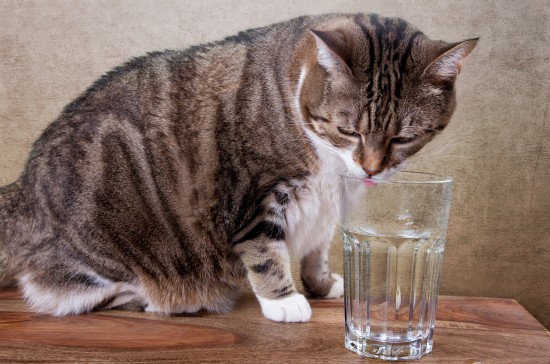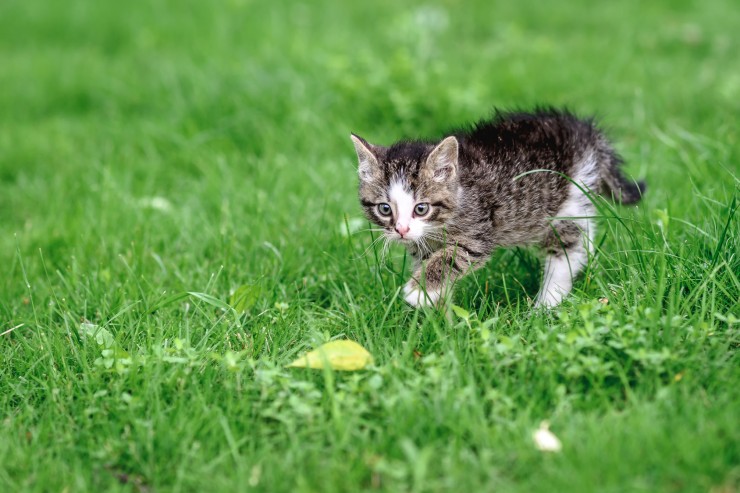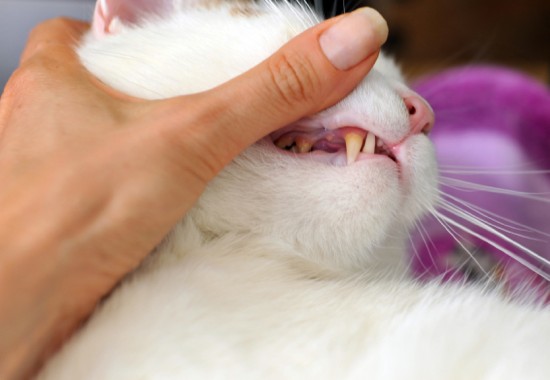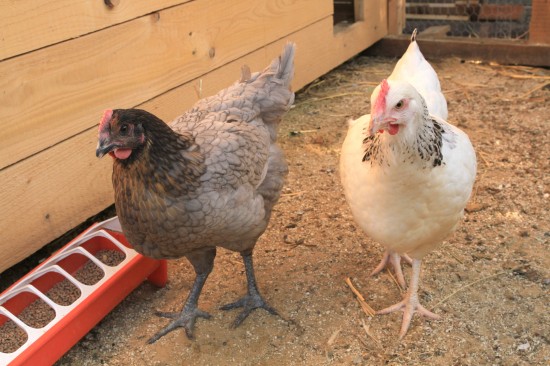
Cats prefer foods at body temperature—the temperature of freshly killed prey. They also prefer their food cut into ¼ inch chunks (especially when they are sick and need to be tempted.) And did you know that 60% of all cats like cold tomato juice? I’ve tried V-8 and it doesn’t seem to be at all tempting. We use this trick to entice kidney-failure cats to drink more liquids.
Cats are either right or left handed, showing a distinct preference for one paw over the other.
A healthy domestic cat can reach speeds up to 31 miles/hour, but can’t maintain that sprinting speed for more than a minute.
A cat licks their fur to keep cool in hot weather. Like dogs, they sweat only through the pads of their feet.
The cat’s whiskers are specially adapted to act as antennae. They are used to navigate, to detect movement and to judge the width of an opening. Whiskers are also an indicator of mood—when the whiskers are back, the cat is angry, so watch out. Some people think finding a whisker is good luck. I know one woman who is a millionaire that has a cat whisker collection!
Each cat ear is controlled by 32 muscles and can turn 180 degrees. Humans have only 6 muscles, so it’s harder to make our ears wiggle. Cat ears that are facing back or folded down are really ticked off, so watch out.
A cat’s fur has 60,000 hairs per square inch on the back and 120,000 hairs per square inch on the underside—No wonder cat owner’s have to empty their vacuum bags every time! Shedding is controlled by hormones and ambient temperature as well as light—even artificial light. Nervous cats shed more—especially when they get stuffed into a carrier and hauled off to the vet’s office.
Cats are highly territorial. A domesticated cat’s territory encompasses 150 acres. Apparently their acres intermingle as we see about eight cats in our backyard every day as they make their rounds. Only one is ours—there’s lots of neat cat entertainment stuff in our yard.
Jumpability: The human equivalent of the cat’s ability to leap would be jumping the width of a swimming pool.
Sense of smell: Humans have 5 million odor-sensitive cells in their noses—cats have 200 million. Of course this means they can smell when you don’t clean the litter box every day and will “inappropriately urinate” because of this.
Sleep habits: A healthy mature cat spends about 15% of its life in deep sleep, 50% in light sleep, and 30% in awake time. I’ve noticed that part of this wake time coincides with the human’s sleep time. This annoys the cat. This could be why my cat, Dagney, wakes me up about 2 a.m. every morning by sticking her paw in my mouth. Bleck! Cats attain full alertness faster than any other creature.
Milk Drinking: Most adult cats lack the enzymes necessary to digest milk, so if you must give your cat milk, be sure to give them only a couple teaspoons at a time. Yep—too much milk definitely gives the cat gas and sometimes diarrhea. It’s good to coordinate the milk-giving ceremony with your partner so that the cat does not double-dip.
Dieting: Neutered and spayed cats require fewer calories than intact cats do. A good rule of thumb is ½-3/4 cups per cat per day for lower quality foods and 1/3 cup per cat per day for the higher quality foods such as IAM’s, Max Cat, and Nutranuggets. Putting fat cats on starvation diets can kill them because the liver fat breaks down too fast causing a condition called ketosis.
Skin Disease: I’ve noticed in my naturopathic practice that cat’s with skin disease like fish flavors. Cats with liver and kidney disease like Chicken and Giblet or foods with liver and kidney in them. Cat’s with heart disease like heart-based foods. When the condition is repaired, they stop eating that particular flavor of food.
Hearing: Human beings can hear sounds up to 20,000 Hertz (cycles per second), dogs can hear up to 40,000 Hertz, and cats can hear up to 100,000 Hertz. Cats can even hear electrical currents in cords. Pretty amazing, huh?
Psychic: In China, cats have been used successfully as earthquake predictors for years.
Cats are color blind, but only need 1/6th of the light that humans require to see.
Cat digits: Cats have five toes on their front paws and four on their back. A polydactyl cat has more than the normal number of toes. Poly means many and dactyl means fingers (your Latin lesson for the day.) Polydactyl cats are known by various names – “mitten cats,” “thumb cats,” “six-finger cats” and “Hemingway cats.” Hemingway cats were named after Ernest Hemingway who shared his home island with nearly 50 cats, including a 6-toed polydactyl given to him by a ship captain; the cats bred and the polydactyl trait became common. Hemingway’s colony of cats was free-breeding with the local cat population and the ratio of polydactyl cats to normal-toes cats was about 50/50. There is a high rate of polydactyl cats in Boston, MA and in Portland, OR. I love polydactyl cats as they seem to be very friendly and tolerant of humans of all ages.
Why spay your cat? A single pair of cats and their offspring can produce as many as 420,000 cats in just seven years.
Cats like to hear whispering.
The cat has 26 facial expressions. The same parts of the human and feline brain correspond to emotion.
Cats show the following signs when stressed: Over-grooming, lack of grooming, self-mutilation, vocalization, aggression, listlessness, loss of appetite, depression. The product Feliway is an excellent product to alleviate stress for cats in new situations or in multi-cat environments where they don’t have enough space to make them feel comfortable.
Feliway is a synthetic feline pheromone use to control inappropriate urine marking behavior and to reassure cats in strange surroundings.
Cat Communication: Cats interpret a smile that shows teeth as aggression. This may be one reason why a cat will always go to the person who hates cats (they don’t smile at the cat or make direct eye contact!)
Please feel free to use any or all of the above tips as long as the reference box is noted.
Dr. Denice Moffat is a practicing naturopath, medical intuitive, and veterinarian working on the family unit (which includes humans and animals) through her phone consultation practice established in 1995. She has a content-rich website at http://www.NaturalHealthTechniques.com and free monthly newsletter.
Article Source: http://EzineArticles.com/?expert=Denice_Moffat
 Why And When Do You Need Pet Sitting Services?
Why And When Do You Need Pet Sitting Services?
 Breed History And Formal Recognition Of The Biewer Terrier
Breed History And Formal Recognition Of The Biewer Terrier
 Why Is My Dog / Cat Drinking More?
Why Is My Dog / Cat Drinking More?
 Some Frequently Asked Questions About Cats And Hunting Behaviour
Some Frequently Asked Questions About Cats And Hunting Behaviour
 Dental Problems In Cats
Dental Problems In Cats
 Five Ways That Many Dog Owners Inadvertently Do Their Dogs A Disservice
Five Ways That Many Dog Owners Inadvertently Do Their Dogs A Disservice
 What To Do If You Suspect That An Animal Is Being Mistreated
What To Do If You
What To Do If You Suspect That An Animal Is Being Mistreated
What To Do If You
 Cats And Catnip
Cats And Catnip
Cats And Catnip
Cats And Catnip
 Finding Out More About The Shorkie Hybrid Dog Breed
Finding Out More
Finding Out More About The Shorkie Hybrid Dog Breed
Finding Out More
 What Is Coccidiosis And How Does It Affect Chickens?
What Is Coccidios
What Is Coccidiosis And How Does It Affect Chickens?
What Is Coccidios
 18 Questions About Genetics That Responsible Breeders Should Know The Answers To
18 Questions Abou
18 Questions About Genetics That Responsible Breeders Should Know The Answers To
18 Questions Abou
Copyright © 2005-2016 Pet Information All Rights Reserved
Contact us: www162date@outlook.com